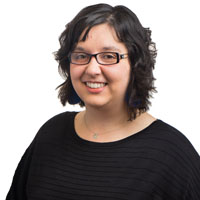-Andrew Ng, Coursera
Historical Context
Massive Open Online Courses, or MOOCs, are online classes designed for unlimited participation, massive numbers of students, and free, open access via the internet. A relatively new approach to learning, many consider MOOCs to be the latest generation of distance learning. Distance learning began with correspondence study, which became popular after the Industrial Revolution as factories needed a more qualified workforce and the postal service was increasing its reach, speed and reliability. Electronic media ushered in the second generation of distance learning with the use of radio and television. Students in greater numbers could take advantage of content from all over the world, even when they could not access formal education. Still, this second generation of learning lacked key pedagogical factors – direct, real-time interaction with other students and the instructor.
A new initiative in the UK was the impetus for the third generation of distance learning. Established in 1969, the Open University combined correspondence learning, the use of radio and TV, and residential short courses. In a departure from previous versions of distance learning, the Open University’s online courses and learning materials were open to all students with an internet connection. This departure from previous versions of distance learning is said to have been a key influence in the rise of the MOOC movement.
Beginnings of the MOOC Movement
The term MOOC was first used in 2008 to describe an open online course designed by George Siemens (formerly of Athabasca University) and Stephen Downes (National Research Council of Canada). The course, "Connectivism and Connective Knowledge," was presented to 25 tuition-paying students at the University of Manitoba, and took advantage of computers and the internet to provide access to more than 2,000 members of the general public who took the class for free. All content was available through RSS feeds and learners could participate with threaded discussions and simultaneous online meetings.
Three years later, in 2011, Sebastian Thrun and Peter Norvig of Stanford University designed and led the first American MOOC. The course, “Introduction to Artificial Intelligence,” emphasized the “massive” in MOOC; it attracted more than 160,000 students. Thrun built a business modeled around the success of this course, the start-up Udacity, and within a year, two more startup MOOC platforms appeared: Coursera and the Harvard-MIT partnership edX. Outside the United States, Open University built a platform called Futurelearn, Australia launched Open2Study and Germany created iversity, all offering MOOCs to students around the world. The New York Times, perhaps rightly, called 2012 the “year of the MOOC” as people around the world signed up by the thousands – as many as 100,000 in one course – to take classes in math, science, humanities, and other subjects taught by professors at major universities in the United State and abroad.
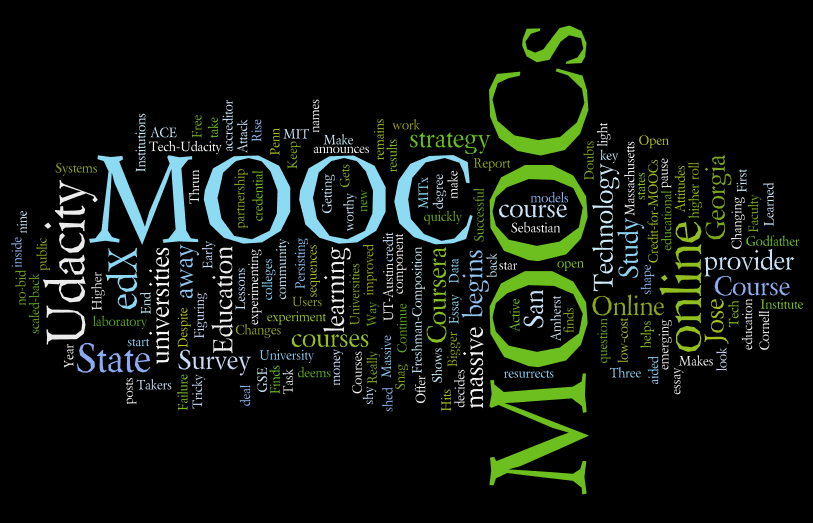
Word Cloud of Headlines from articles about MOOCs (2012)
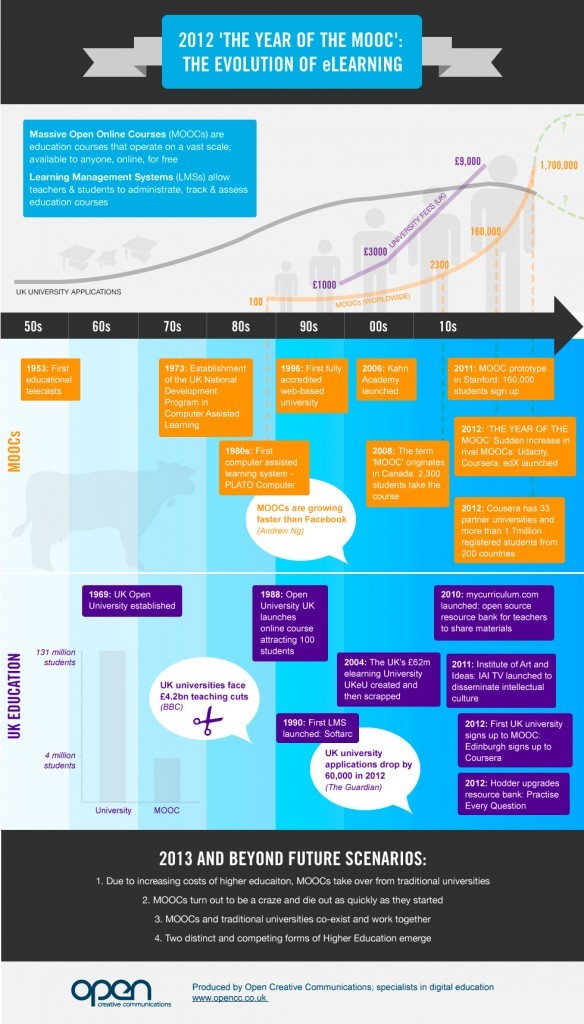
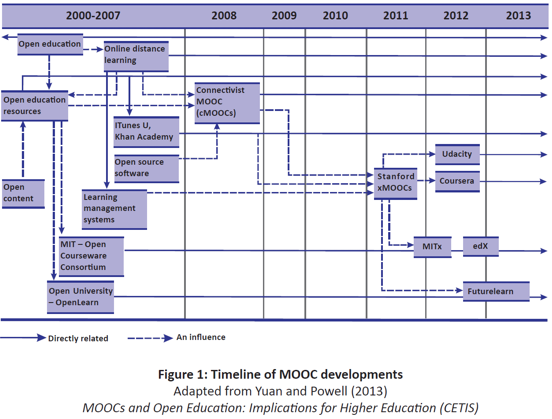
What is a MOOC?
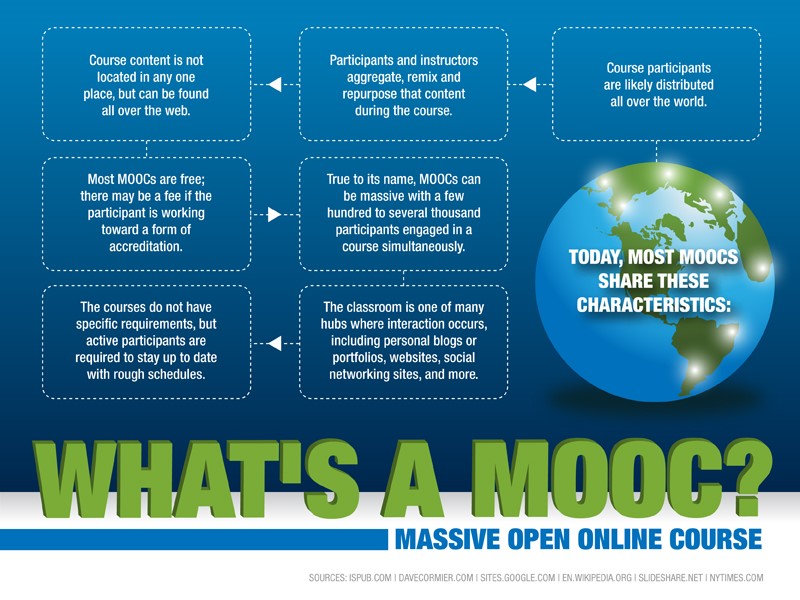
Continuing Evolution
Defining a MOOC is a challenge as the courses in 2008 looked quite different from those being offered in 2014. MOOC 1.0, defined by the first MOOC, “Connectivism and Connective Knowledge,” focused on open educational resources and a peer-learning model, but not necessarily the high enrollments we have come to associate with MOOCs today. MOOC 2.0 raised the profile of MOOCs with massive enrollments and global reach seemingly the norm, and by necessity no admission requirements and low faculty interaction. MOOCs of this era were developed and exported by prestigious universities. These MOOCs often used a video lecture format where ownership of the course content and platform design was maintained and protected by the course developers and their institutions. Perhaps most noteworthy is how these courses experimented with personalized learning technology and provided data to determine the unique learning needs of each student.
MOOC 3.0 has shifted the model once again – now the higher education institutions are importing MOOCs, not as complete courses, but as components used by institutions or individual faculty members on an as desired basis. These components may contribute to flipped classrooms or be used as extra practice and assistance for students who may be struggling.
More About MOOCs:
Listen to Dave Comier talk about MOOCs
Welcome to the Brave New World of MOOCs from the New York Times
Classifying MOOCs
The literature on MOOCs generally agrees that there are two different kinds of MOOCs: cMOOCs and xMOOCs. cMOOCs are closely based on the original connectivist distributed peer learning model such as the one developed at the University of Manitoba. These courses are typically developed and led by academics through open source web platforms. The cMOOC model has been much less popular in the larger MOOC platforms (see below for more on MOOC platforms), perhaps due to the pedagogical knowledge needed to produce a cMOOC.
xMOOCs are designed on large MOOC platforms and based on a format of minimal support with a subject expert recording content and planning assessment for the student cohort to complete at a time of their own choosing. The aim is allow the platform to run the same classes repeatedly throughout the year on a rolling basis.
A Unique Model
MOOCs differ from more traditional postsecondary online courses in several important ways. While traditional courses generally charge fees (tuition), award credit, follow a scheduled curriculum, and limit enrollment to foster instructor-student relationships, MOOCs:
- Are free (usually)
- Award no credit
- Can be either synchronous (students enroll and process through the course together at relatively similar paces) or asynchronous (self-paced where students can join at any time after the start date and take as little or as much time as they need to complete the course)
- Enroll massive numbers of students, typically in the thousands, at once
- Encourage connections between and among students in online forums or study groups instead of with an instructor
Existing MOOC Platforms
As mentioned previously, Stanford’s experiment with MOOCs led to a number of new platforms for MOOC content. The larger American platforms for MOOCs are Coursera, edX and Udacity.
Coursera: Founded in 2012 by Stanford professors Daphne Koller and Andrew Ng, Coursera is a for-profit educational enterprise and is currently the largest MOOC platform in terms of university partners, number of courses, and student enrollment. As of May 2014, Coursera had over 100 partners, over 600 courses and over 5 million students enrolled.
edX: MIT launched its MITx platform in 2011 and subsequently incorporated it into a not-for-profit venture between MIT and Harvard called edX. The consortium has more than 30 university members, including MIT, Harvard, Berkeley, University of Texas System, Wellesley College, Georgetown, Australian National University, and McGill. Over 150 courses are offered through edX and its partners.
Udacity: Udacity was established by Sebastian Thrun in 2011 following the initial offering of his artificial intelligence MOOC at Stanford. It is a for-profit enterprise that works with industry leaders and technology firms to develop technology and computer science-related courses to deliver content desired by employers. (Readers should note this is a departure from Udacity’s initial mission, which was “to provide great education to anyone in the world at little or no cost.”) Udacity currently offers over 30 courses and partners with organizations such as Google, Facebook, and Cloudera.
FutureLearn, Open2Study, and Iversity are MOOC platform spinoffs from the UK’s Open University, Open Universities Australia and a German educational start-up, respectively. The three are at various stages of development and may someday become competitors to the primary American platforms.
While two of the three major American MOOC platforms are for-profit organizations (edX and Coursera), there is not yet a clear and sustainable business model that will ensure MOOCs’ long-term success. Coursera is making some headway and in April of 2013 announced a $220,000 first quarter profit (the first time they generated a profit). The profit was realized in part by charging for verified course completion certificates (which cost a user from $50-70). The platform also collected revenue from an Amazon.com affiliates program in which Amazon.com shares some of the profits when Coursera users buy books suggested by instructors. There are other ideas not yet explored, including those listed in the contract between Coursera and The University of Michigan below (released in July of 2012 by The Chronicle of Higher Education). Time will tell how these ideas might translate into profits for MOOC platforms.
How might Providers Earn Revenue from MOOCs?
- Secure assessments (students pay to have their examinations evaluated)
- Employee recruitment (companies pay for access to student performance records)
- Applicant screening (employers/universities pay for access to records to screen applicants)
- Human tutoring or assignment marking (for which students pay)
- Selling the MOOC platform to enterprises to use in their own training courses
- Sponsorships (third party sponsors of courses
Mooc Research
With the relatively quick rise of popularity and interest surrounding MOOCs, many have asked about their effectiveness and impact. Empirical evidence is relatively recent but essential questions about MOOC students’ motivations and learning behaviors, and how those behaviors correlate with persistence and achievement, have started to be addressed in the online learning literature.
Research indicates that 1) most MOOC users have already earned a postsecondary degree and are working professionals; 2) a majority of MOOC users enroll because of interest in the subject matter; and 3) completion rates for MOOCs are quite low, ranging from 2% to 14%. While initial data might lead to questions about MOOCs’ efficacy, researchers caution against jumping to conclusions too soon. Many researchers in the online learning space would offer the following caveats when providing analysis on currently available data:
- MOOC users are not like conventional students: using completion rates and enrollment rates as the sole factors in determining effectiveness may provide an incomplete picture of success. There might be significant learning and engagement even from those students who take only one or two lessons, or who just watch posted videos.
- Current data describes activity only, not learning gains. To delve deeper into questions of student learning, we would likely need to invest in high-quality, scalable assessments and research designs.
- MOOC users have radically different goals, motivations, backgrounds and experience than conventional education consumers, which makes assessing MOOC effectiveness very difficult and time consuming.
- MOOC data proves to be quite challenging to analyze and requires significant effort to transform, interpret, understand and use. There is no agreement on methods across researchers or institutions on defining and collecting data in this growing field.
While much of the research offers an optimistic view of the impact of MOOCs on student learning, other research questions how well MOOCs serve particular populations, especially underserved populations. Low-income students, academically underprepared students, and ethnic minorities have shown to benefit much more from frequent, meaningful, and in-person instructor-student interactions and tend to enroll in courses that offer them these options . While MOOCs might improve access to college level learning among tech savvy working adults who hope to upgrade their skills, it is not clear that they will improve access and success for underserved populations.
Current Landscape
There is certainly no way to define a “typical” MOOC user. Using HarvardX’s (HarvardX Insights) and MITx’s (MITx Insights) interactive insights tools, researchers can view student enrollment in specific courses on a global scale by geographic location, gender, age, and education attainment. According to this data, students span every continent and a wide range of ages. MOOC topics cover everything from biology to English, from coding to public speaking, from comic books to the great books. MOOC List is a central, independent website that lists all MOOC courses across platforms worldwide. The ways that universities use MOOCs are also varied. Institutions are entering into partnerships with platform providers to offer courses and online degrees to their own students as well as to provide open access to certain courses to students from across the world. Based on recent research from Columbia University’s Teachers College, institutions usually have one or more of six major goals for MOOC initiatives:
- Extending the reach of the institution and access to education,
- building and maintaining brand,
- improving economics by lowering costs or increasing revenues,
- improving educational outcomes for both MOOC participants and on-campus students,
- innovation in teaching and learning, or
- conducting research on teaching and learning.
San Jose State University, in perhaps the most widely publicized case, collaborated with Udacity in 2013 to offer a series of remedial and introductory courses to its students. This was the first time that professors at a university collaborated with a provider of a MOOC to create for-credit courses. After six months of experimentation, in July of the same year, the university ‘paused’ their deal with Udacity citing disappointing student outcomes and a lack of time to properly prepare for the initiative’s launch. In December of the same year, the university announced that it would continue three of the five courses developed through their partnership with Udacity, but these courses would be absorbed by the university and integrated back into their own framework, effectively ending the experiment with the MOOC provider.
There have been other high profile MOOC experiments, including Georgia Institute of Technology’s online master’s degree program in computer science, the first of its kind offered on a MOOC platform. The overall cost to the student is under $7,000 and enrollment is expected to rise over time from its first class of 375 students.
Critiques
MOOCs have received as much criticism as praise in recent years for failing to address the significant challenges they face, primarily with regard to quality and sustainability. Some of the more prominent critiques are those regarding quality assurance and sustainability.
- Quality: Though most MOOCs are offered through well-known institutions of higher education, the reputation of a home university does not guarantee the quality of teaching and instruction of a MOOC.
- Altruism vs. Profit: Tension exists between the philanthropic aims of MOOC platform founders (i.e. educate the world for free) and the motivations of venture capitalist backers.
- Sustainability of current model: Given how expensive it can be to create a MOOC (some estimates run up to $100,000 per course), cost could limit many universities from adopting MOOCs unless there is a profit model developed.
- Longevity: Many believe that the MOOC phenomenon is overhyped and is, in fact, already obsolete. They point to past examples of renowned higher education institutions becoming involved with new online learning platforms or technologies that ultimately failed, like the San Jose State University example discussed above.
- Completion rates: MOOCs average a 6% completion rate, with most users dropping out without completing even one lesson.
- Credit: While organizations like the American Council on Education have deemed five MOOCs worthy of credit, the actual transferability of these credits has yet to be determined.
- Institutional buy-in: A Gallup survey of faculty members found significant skepticism among respondents about the quality of online learning, with only one in five agreeing that online courses can achieve learning outcomes equivalent to those of in-person courses. The majority of faculty believe online courses are of lower quality.
- Accreditation: Currently no accreditors offer course-level accreditation and no path to federal financial aid exists for students to pay for MOOCs with federal student aid and/or earn academic credit for MOOC learning.
Questions for Policymakers
The federal role in the development and sustainability of MOOCs remains to be seen. Policymakers should consider the following questions as the MOOC movement continues to evolve:
- What role can MOOCs play in increasing access to higher education among underserved populations?
- What role can online models of delivery play in improving the quality and affordability of online and traditional courses for students, employers and society-at-large?
- What are the costs of developing and running MOOCs and what are the wider implications of offering free course content for existing business and pedagogical models?
- How might MOOC courses be “accredited” to ease the path toward earning academic credit?
- What effect might the rise in popularity of MOOCs have on college costs? What impact might MOOCs have on enrollment in more traditional courses or institutions?
- Should federal student aid be allowed to cover the costs of MOOC courses?
- Should state funding/aid be allowed to cover costs of MOOC courses?
- For research purposes, how does FERPA apply to MOOC participants and data sharing among institutions?
- How might employers use MOOCs to fill in the skill gaps of their current employees or recruit and hire new talent?
- How might support for open platforms / learning materials (and research about them) spur efficient & timely innovation?
Looking to the Future
In a field where change has historically happened very slowly, MOOCs are evolving rapidly and disrupting the conventional understanding of higher education. It is hard to dispute, however, that this disruption has pushed for greater innovation in postsecondary education more generally and raised important questions about the value of the more traditional brick and mortar educational experience and degree.
Further Reading and Resources
Adams, Susan. “Are MOOCs Really a Failure?” Forbes. 11 Dec 2013.
The Economist. “The Attack of the MOOCs.” 20 July 2013. Hollands, Fiona and Tirthali, Devayani. “MOOCs: Expectations and Reality." Center for Benefit-Cost Studies of Education, Teachers College, Columbia University. May 2014.
Hu, Helen. “MOOCs Changing the Way We Think About Higher Education.” Diverse Issues in Higher Education. 1 Apr. 2013.
Kelly, Andrew. “Disruptor, Detractor, or what? A Policymaker’s guide to massive open online courses.” AEI. 15 May 2014.
Kolowich, Steve. “The Professors who Make the MOOCs.” The Chronicle of Higher Education. 18 Mar 2013.
Kolowich, Steve. “A University’s Offer of Credit for a MOOC Gets No Takers.” The Chronicle of Higher Education. 8 July 2013.
Marcus, Jon. “MOOCs Keep Getting Bigger. But do they work?” 12 Sept 2013. The Hechinger Report.
Popp, Trey. “MOOC U.” The Pennsylvania Gazette. Mar/April 2013. Radford, Alexandria Walton; Robles, Jessica; Cataylo, Stacey; Horn, Laura; Thornton Jessica; Whitfield, Keith. “Employer Potential of MOOCs: A Survey of Human Resources Professionals’ Thinking on MOOCs.” Duke University and RTI International. 25 Mar 2014.
Thrift, Nigel. “To MOOC or Not To MOOC.” The Chronicle of Higher Education. 13 Feb. 2013. Rivard, Ry. “Georgia Tech and Udacity roll out massive new low-cost degree program.” Inside Higher Ed. 14 May 2013.
Reich, Justin and Ho, Andrew. “The Tricky Task of Figuring out What Makes a MOOC Successful.” The Atlantic. 23 Jan 2014.
